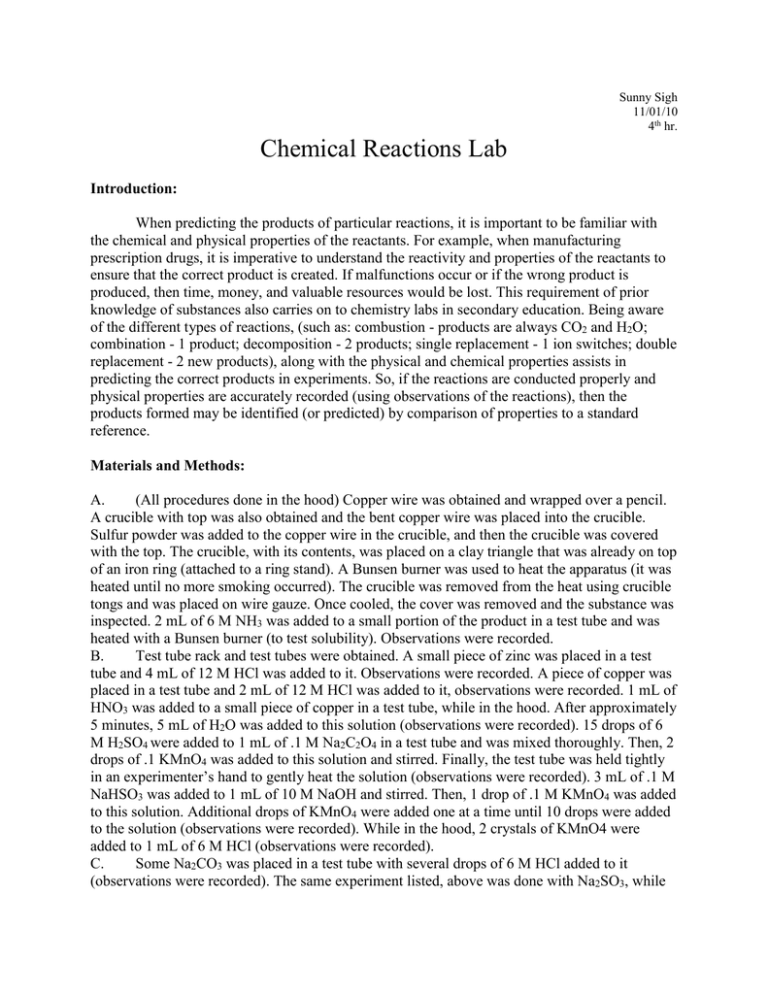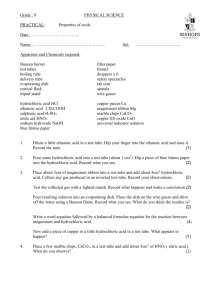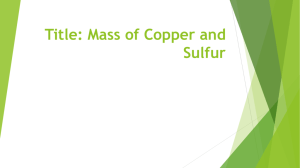chemicalrxnslab - WaylandHighSchoolChemistry
advertisement

Sunny Sigh 11/01/10 4th hr. Chemical Reactions Lab Introduction: When predicting the products of particular reactions, it is important to be familiar with the chemical and physical properties of the reactants. For example, when manufacturing prescription drugs, it is imperative to understand the reactivity and properties of the reactants to ensure that the correct product is created. If malfunctions occur or if the wrong product is produced, then time, money, and valuable resources would be lost. This requirement of prior knowledge of substances also carries on to chemistry labs in secondary education. Being aware of the different types of reactions, (such as: combustion - products are always CO2 and H2O; combination - 1 product; decomposition - 2 products; single replacement - 1 ion switches; double replacement - 2 new products), along with the physical and chemical properties assists in predicting the correct products in experiments. So, if the reactions are conducted properly and physical properties are accurately recorded (using observations of the reactions), then the products formed may be identified (or predicted) by comparison of properties to a standard reference. Materials and Methods: A. (All procedures done in the hood) Copper wire was obtained and wrapped over a pencil. A crucible with top was also obtained and the bent copper wire was placed into the crucible. Sulfur powder was added to the copper wire in the crucible, and then the crucible was covered with the top. The crucible, with its contents, was placed on a clay triangle that was already on top of an iron ring (attached to a ring stand). A Bunsen burner was used to heat the apparatus (it was heated until no more smoking occurred). The crucible was removed from the heat using crucible tongs and was placed on wire gauze. Once cooled, the cover was removed and the substance was inspected. 2 mL of 6 M NH3 was added to a small portion of the product in a test tube and was heated with a Bunsen burner (to test solubility). Observations were recorded. B. Test tube rack and test tubes were obtained. A small piece of zinc was placed in a test tube and 4 mL of 12 M HCl was added to it. Observations were recorded. A piece of copper was placed in a test tube and 2 mL of 12 M HCl was added to it, observations were recorded. 1 mL of HNO3 was added to a small piece of copper in a test tube, while in the hood. After approximately 5 minutes, 5 mL of H2O was added to this solution (observations were recorded). 15 drops of 6 M H2SO4 were added to 1 mL of .1 M Na2C2O4 in a test tube and was mixed thoroughly. Then, 2 drops of .1 KMnO4 was added to this solution and stirred. Finally, the test tube was held tightly in an experimenter’s hand to gently heat the solution (observations were recorded). 3 mL of .1 M NaHSO3 was added to 1 mL of 10 M NaOH and stirred. Then, 1 drop of .1 M KMnO4 was added to this solution. Additional drops of KMnO4 were added one at a time until 10 drops were added to the solution (observations were recorded). While in the hood, 2 crystals of KMnO4 were added to 1 mL of 6 M HCl (observations were recorded). C. Some Na2CO3 was placed in a test tube with several drops of 6 M HCl added to it (observations were recorded). The same experiment listed, above was done with Na2SO3, while in the hood (observation were recorded). Again, the same experiment was done instead with ZnS, while in the hood (observations were recorded). A few drops of 6 M HCl was added to 1 mL of .1 M Pb(NO3)2 in a test tube (observations were recorded). 1 mL of .1 M BaCl2 solution was placed in a test tube, then 2 drops of 1 M K2CrO4 were added to it (observations were recorded). Several drops of 3 M (NH4)2CO3 were added to 1 mL of .1 M BaCl2 in a test tube. After the excess liquid was decanted, 1 mL of water was added to the test tube, which was shaken. Once the precipitate settled, the liquid was decanted once again. Lastly, several drops of 6 M HCl were added to the remaining solid (observations were recorded). Results: Physical Observations: A. 7. (copper (1) and sulfur, then product with ammonia) The substance does not resemble copper, it was not flexible, blackish-gray color. A reaction occurred, but sulfur was not there. The product dissolved (reacted) when placed in ammonia (blue solution). B. 9. (zinc and hydrochloric acid) Reaction occurred, lots of bubbles (warm test tube). Black ppt formed? 11. (copper and hydrochloric acid) No reaction, yellowish liquid. 15. (copper and nitric acid) The solution turned blue/light green, all of the copper dissolved. The gas was orangish-brown. After adding water, the color of the solution turned pale/light blue (evidence for presence of copper ions). 16. (sodium chromate and sulfuric acid, then potassium permanganate) No reaction occurred, until test tube was heated (using hands). The solution turned clear. 17. (sodium bisulfate and sodium hydroxide, then potassium permanganate) The solution turned teal, then olive green, then dirty green. After additional drops of potassium permanganate were added, the solution turned more blue, darker, then dark forest-green, then poop-green. 20. (potassium permanganate crystals and hydrochloric acid) The product was a brownish-purple liquid, it also fizzed a little. Yellow, orange-brown gas evolved. C. 26. (sodium carbonate and hydrochloric acid) Fizzed (rxn.), luke-warm. White ppt formed (probably just the gas)? Could not sense odor and color of gas, gas was white in the beginning? 29. (sodium sulfite and hydrochloric acid) Seemed as if no reaction occurred, however there were a scarce amount of bubbles present around the edges. 32. (zinc sulfide and hydrochloric acid) Some bubbles were present (tiny rxn.), solution looked milky. 35. (lead nitrate and hydrochloric acid) Fizzed (rxn.), white ppt formed, ppt looked flaky. 38. (barium chloride and potassium chromate) Milky, looked yellowish pale? Looked like ppt was not present. 40. (ammonium carbonate and barium chloride, then water added, then hydrochloric acid) Reaction occurred, ppt was white and had a fine texture to it. After it was double decanted, the solution was added with hydrochloric acid, forming a white, fog-like gas (with the odor of an erasure). Conclusions: Equations: A. 7. 16Cu(s) + S8(s) 8Cu2S(s) B. 9. Zn(s) + 2HCl(aq) ZnCl2(aq) + H2(g) C. 26. 2HCl(aq) + Na2CO3(s) 2NaCl(aq) + H2O(l) + CO2(g) 29. 2HCl(aq) + Na2SO3(s) 2NaCl(aq) + H2O(l) + SO2(g) 32. 2HCl(aq) + ZnS(s) ZnCl2(aq) + H2S(g) 35. Pb(NO3)2(aq) + 2HCl(aq) PbCl2(s) + 2HNO3(aq) 38. BaCl2(aq) + K2CrO4(aq) 2KCl(aq) + BaCrO4(s) 40. (NH4)2CO3(aq) + BaCl2(aq) 2NH4Cl(aq) + BaCO3(s) In the first experiment (A.-7.), copper and sulfur reacted to produce copper (1) sulfide. The substance did not resemble copper (flexible, blackish-gray; according to table 4.1, the color of copper (1) sulfide is black) and there were no signs of sulfur present after the reaction. And since this product reacted with ammonia, it is believed to be copper (1) because copper (1) sulfide dissolves in ammonia, whereas copper (2) sulfide does not. In the next experiment (B.9.), zinc was added to hydrochloric acid to produce zinc chloride and hydrogen gas (colorless and odorless, as observed). Evidence for this assertion lies within the observation of the obvious reaction (bubbling occurred). However, it was also observed that a black precipitate formed, which is puzzling because it does not fit in with the equation (most likely human error). In the third experiment (B.-11.), hydrochloric acid was added to copper. It was observed that no reaction took place (no bubbles, just yellowish liquid), which is logical, since copper is lower than hydrogen on the activity series. The fourth experiment (B.-15.), involved the addition of nitric acid to copper to yield copper (2) nitrate and hydrogen gas. The color of the solution after the reaction was blue/light green and all of the copper dissolved which validates the creation of copper (2) nitrate (according to table 4.1, the color of copper (2) nitrate is blue). But it’s paradoxical, since copper is lower than hydrogen on the activity series. There is an exception when a concentrated acid is used (in this case, nitric acid). The other discrepancy was that the color of the gas appeared to be orangish-brown, yet hydrogen has no color or odor (again, human error). The next experiment (B.-16.) used sodium chromate and sulfuric acid, then a couple of drops of potassium permanganate. Initially, no reaction occurred, until the addition of heat (by using human hands). The solution was purple due to the potassium permanganate, yet once the heat was added, the solution turned clear (or very pale pink). This examination provides evidence for the reduction of potassium permanganate to manganese (2+). In the sixth experiment (B.17.), sodium hydroxide was added to sodium bisulfate, then potassium permanganate was added. The solution turned teal, then olive green, then to dirty green. The more potassium permanganate added, the more darker the solution became (giving evidence that it was reduced). The manganese compound that formed was a manganese oxyanion (2-), based on table 4.1 (dark green). The following experiment (B.-20.), utilized potassium permanganate crystals and hydrochloric acid. The result was a brownish-purple liquid that fizzed a little. The color of the gas was yellow/orange-brown, based on that observation and table 4.1, the gas that evolved was chloride gas (closest match, plus it was done in the hood because it’s toxic). (Note, the following are all in the hood). In the eighth experiment (C.-26.), sodium carbonate and hydrochloric acid were added together. It fizzed and seemed as if a white precipitate was formed. The color of the gas may have been white/clear in the beginning of the reaction. Based on the equation and table 4.1, the gas that evolved was carbon dioxide (colorless, odorless). The next experiment (C.-29.), used sodium sulfite and hydrochloric acid. At first, it seemed as if no reaction took place, however, there were a few bubbles around the edges. The gas that evolved was sulfur dioxide, based on the equation and table 4.1 (colorless, choking odor, and toxic). The tenth experiment (C.-32.), used zinc sulfide and hydrochloric acid, producing a tiny reaction (some bubbles) that looked milky. Based on the equation, observations, and table 4.1 the gas was hydrogen sulfide (colorless, rotten-egg odor, and toxic). In the eleventh experiment (C.-35.), hydrochloric acid was added to lead nitrate, which fizzed and formed a white, flaky precipitate. Based on the equation, observations, and table 4.1, the precipitate that formed was lead (2) chloride (color is white, according to table 4.1). The next experiment (C.-38.), potassium chromate was added to barium chloride, giving a milky-pale, yellow solution. Apparently, according to the observations, no precipitate formed. However, this was incorrect, due to the equation giving the solid barium chromate. Based on table 4.1, the color of barium chromate is yellow (observations got that part right), however it did not seem that a precipitate formed in the experiment. In the last experiment (C.-40.), ammonium carbonate was added to barium chloride, then water was added (after decanting excess liquid). Once water was added, the test tube was shaken, then decanted (double-decanted). Several drops of hydrochloric acid were added to the result. The observations state that a white, fog-like gas formed from the reaction that smelled like erasures (like the ones on #2 pencils). Based on the observations, the equation, and table 4.1, the gas that evolved was carbon dioxide (colorless and odorless). Most results were reasonable and sensible, but some had inconsistencies to it. These most likely originate from human error, which could have been caused by the frantic behavior of the experimenters (to complete all experiments) and most likely the perception of the observations (no two experimenters see the exact same thing). So judgment and interpretation of the observations, along with the “fast” atmosphere may have caused the majority of human error. Again, properly carrying out and observing reactions allows for a more accurate prediction/identification of the products. Whether that be in a high school chemistry lab or in a huge, high-tech pharmaceutical corporation, following procedures in a timely and efficient manner matters.




